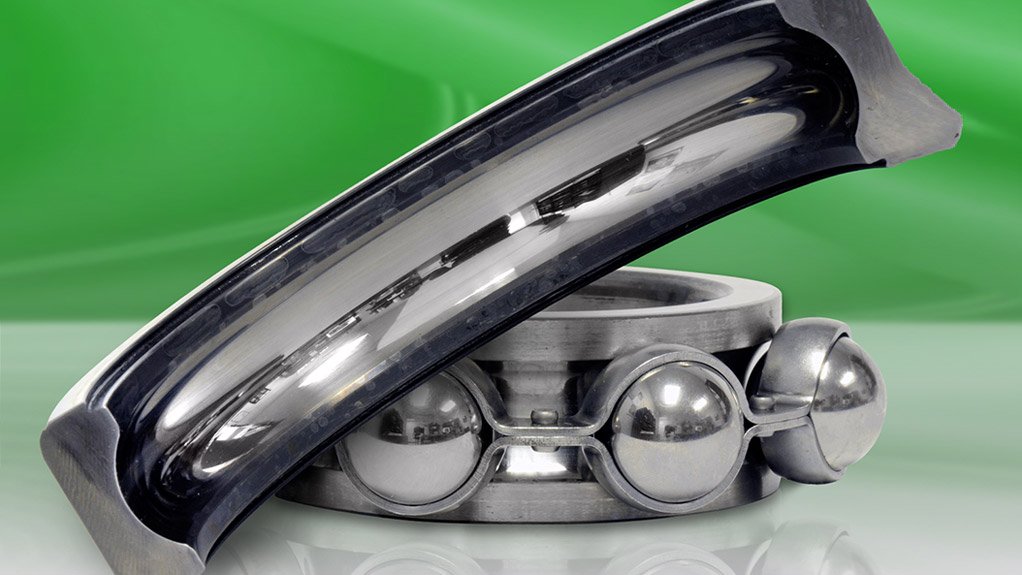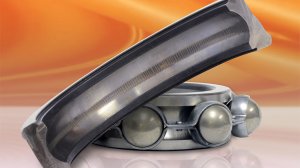Bearing protection needed for optimum performance



FAILED MOTOR The fluted bearing race wall resulted from variable frequency drive-induced bearing currents
AEGIS PROTECTED The race is undamaged as Aegis SGR Bearing Protection Ring protects it
Major manufacturers of three-phase alternating current induction motors offer inverter-duty or inverter-ready models but, while these motors have inverter-rated insulation to protect the windings, the bearings, which are the motors’ most vulnerable parts, are too often ignored, states global manufacturer and designer of static control devices, Electro Static Technology marketing manager Adam Willwerth.
He says many customers who buy these motors do not understand this.
He adds that the US National Electrical Manufacturers Association (Nema) has yet to recommend that new motors have bearing protection against damaging electrical discharges.
Inverters, also known as variable frequency drives (VFDs) and adjustable speed drives, can induce unwanted motor shaft voltages that, without effective mitigation, can destroy bearings, causing premature motor failure.
Although current Nema standards highlight the possible need for extra bearing protection for VFD-driven motors, they are often not specific enough to guide motor manufacturers and have not been updated to include new research results and developments in shaft-grounding technology, says Willwerth.
“Stronger, reworked standards, calling for effective mitigation in the form of reliable long-term shaft-grounding technology would go a long way toward cautioning motor users of the need for such mitigation and would help to clear up common misconceptions,” he adds.
Willwerth says VFDs can save 30% or more in energy costs. Because of this, they have been cited as a key technology for those wishing to make their commercial heating, ventilation, and air conditioning (HVAC) systems, automated assembly lines, and other processes more energy efficient.
But, whether used to control a motor’s speed or torque, VFDs often induce voltages and currents that can damage bearings. The costly repair or replacement of failed motor bearings can wipe out any savings that a VFD yields and severely diminish the reliability of an entire system.
Advances in Bearing-Grounding Technology
Willwerth says the most reliable and cost-effective way to reduce electrical bearing damage and make these systems sustainable is a motor shaft-grounding ring, combined with insulation for motors larger than 100 hp.
“Unlike older single-point contact brushes, new grounding rings encircle a motor’s shaft with contact points for far greater effectiveness. Electro Static Technology’s Aegis SGR Bearing Protection Ring, has continuous circumferential rows of specially engineered microfibres to boost electron transfer rates and provide low impedance from shaft to frame,” he states.
These rings safely bleed damaging currents to the ground, bypassing a motor’s bearings entirely. Also, because the microfibre brushes work with little or no contact, they do not wear out like conventional brushes.
“Aegis rings have been proven effective in over half a million installations worldwide,” says Willwerth.
Recognising that the best solution is to design motors from the ground up to survive the damaging effects of VFDs, a few forward-looking motor manufacturers have recently added the Aegis ring as a standard or optional feature on certain models.
Motor Failure
Damage to windings and bearings is caused by repetitive and extremely rapid pulses that are applied to the motor from a modern VFD’s non-sinusoidal power-switching circuitry.
This can be described as harmonic content, parasitic capacitance, capacitive coupling, elec-trostatic build-up, and common-mode voltage.
High peak voltages and fast voltage rise times can cause cumulative degradation of insulation, bearings and coil varnish.
If the load impedance is higher than the line impedance, current is reflected back toward the VFD, creating voltage spikes at the motor terminal that can be twice as high as the direct current bus voltage.
The cumulative bearing damage caused by VFD-induced currents is often overlooked until it is too late to save the motor.
Types of Bearing Damage
Without some form of mitigation, shaft currents discharge through bearings, causing unwanted electrical discharge machining that erodes the bearings and race walls and leads to premature bearing or motor failure. These frequent discharges can leave the entire bearing race riddled with pits known as frosting. Electrical damage has become the most common cause of bearing failure in VFD-controlled alternating current motors.
In a phenomenon called fluting, the oper- ational frequency of the VFD causes con-centrated pitting at regular intervals along the race wall, forming washboard-like ridges.
Fluting can cause excessive noise and vibration, which, in an HVAC system, can be magnified and transmitted by ductwork throughout the entire building. By the time this is noticeable, bearing failure is often imminent, Willwerth points out.
The Need for Updated Standards
“In its key role as information provider, Nema is in a position to update its MG1 standard to state more clearly that common mode shaft voltages are present in virtually all motors fed by pulse-width-modulated VFDs.
“Since no other entity is in such a position of authority, Nema could simultaneously tackle the overall problem of electrical bearing damage most clearly and firmly,” Willwerth suggests.
The association’s current standards acknowl-edge the potential damage from VFD-induced voltage spikes. The standards state that motors controlled by modern VFDs containing insulated gate bipolar transistors should be designed to withstand repeated spikes (at the terminals) of up to 3.1 times the motor’s rated voltage, at rise times not less than 0.1 microsecond.
Nema omits common-mode voltages from its standards on larger motors and omits mention of circulating currents from its paragraph on smaller motors. Another problem with Nema’s current language is that neither a grounding brush nor insulation is a reliable, long-term solution to the problem of electrical bearing damage at the system level, which includes motors and attached equipment.
“The Nema standards do, however, correctly point out that insulating the motor bearings will not prevent the damage of other shaft-connected equipment,” states Willwerth.
When the path to the bearings is simply blocked by insulation, the damaging current seeks another path to ground.
That other path can go through a pump, gearbox, tachometer or encoder, which consequently can end up with bearing damage of its own. The economical solution, of course, would be a maintenance-free, long-life shaft-grounding ring that protects attached equipment, as well as the motor’s bearings.
Mitigating Bearing Damage
When designing a true inverter-ready motor, a manufacturer should strive to protect the motor’s bearings, as well as its windings.
“Stronger Nema standards would be an incen-tive for built-in bearing protection that extends motor life,” Willwerth believes.
He states that the following measures have proven effective under actual operating con-ditions and should be considered for inclusion in any Nema standards updates: for motors above 100 hp, where both circulating currents and common-mode voltages could cause bearing damage, combining an insulated bearing on one end with a shaft-grounding ring on the opposite end, which provides the best protection from electrical bearing damage.
For motors up to 100 hp, where common-mode voltages could cause bearing damage, adding a shaft-grounding ring to the motor, either inside the motor or externally, which provides effective protection against bearing currents for motor bearings, as well as attached equipment.
Long-Term Shaft-Grounding Solutions
Other devices that are meant to provide a path to ground, fall short of the Aegis ring, Willwerth claims.
“Although the primary reason is that such other devices wear out faster, there are other reasons for their reduced effectiveness — reasons that limit the effectiveness of all single-point contact brushes,” he notes.
“Metal spring-pressure grounding brushes, for example, are easily contaminated by corrosion or clogged by debris, requiring regular maintenance or replacement.
“Carbon-block brushes have an additional drawback. They are susceptible to hotspotting, in which an arc briefly fuses the brush to the motor shaft. And other contact brush designs quickly wear out, with the result that shaft currents return to discharging in the bearings,” he says.
The above configurations have one thing in common — they rely on direct contact to transfer current. The Aegis ring, however, is unique in that it works both with contact and also without direct fibre contacting the motor shaft. Its contact/non-contact Electron Transport Technology discharges shaft voltages even if its fibres are not touching the motor shaft.
Because it works without contact, the Aegis ring will not wear out and requires no maintenance, regardless of rpm.
“Its patented technology makes it the most effective device for redirecting currents from shaft to ground. Easily installed at the factory or retrofitted later, it makes VFD-controlled systems sustainable by protecting motor bearings from catastrophic failure,” he adds.
Key to the Aegis ring’s success is the proprietary conductive microfibres that completely surround the motor shaft. Secured in the ring’s patented FibreLock channel, these fibres can flex without breaking, and the deep protective channel keeps them away from dust, liquids and other debris. Testing shows surface wear of less than 0.001 per 10 000 hours of continuous operation and no fibre breakage after two-million direction reversals.
The Aegis SGR Bearing Protec- tion Ring is available for any size Nema or International Electro-technical Commission motor. It can be factory-installed inside new motors or quickly and easily retrofitted, even in the field, using conductive epoxy. A new Split uKIT simplifies and speeds up the mounting of the ring on motors with shaft shoulders, slingers, or other end-bell protrusions.
The cost of the Aegis ring and installation is very low, compared with the cost of the overall system, usually less than 1% of the equipment cost. And, by preventing electrical damage to bearings, the ring protects the whole VFD system from costly downtime and unplanned maintenance.
“For motors without adequate bearing protection, the term ‘inverter-duty’ is misleading, as it ignores a major potential cause of premature bearing and motor failure, namely electrical discharge machining. “While some motor manu-facturers are now installing the Aegis SGR Bearing Protection Ring in selected models, most motors labelled ‘inverter-duty’ or ‘inverter-ready’ are still not adequately protected.
“It is incumbent on savvy specifiers to ensure that any motor to be used with a VFD is truly inverter-ready and is equipped at the factory or retrofitted not just with extra winding insulation but also with a shaft-grounding ring and, in certain cases, an insulated bearing,” states Willwerth.
Comments
Press Office
Announcements
What's On
Subscribe to improve your user experience...
Option 1 (equivalent of R125 a month):
Receive a weekly copy of Creamer Media's Engineering News & Mining Weekly magazine
(print copy for those in South Africa and e-magazine for those outside of South Africa)
Receive daily email newsletters
Access to full search results
Access archive of magazine back copies
Access to Projects in Progress
Access to ONE Research Report of your choice in PDF format
Option 2 (equivalent of R375 a month):
All benefits from Option 1
PLUS
Access to Creamer Media's Research Channel Africa for ALL Research Reports, in PDF format, on various industrial and mining sectors
including Electricity; Water; Energy Transition; Hydrogen; Roads, Rail and Ports; Coal; Gold; Platinum; Battery Metals; etc.
Already a subscriber?
Forgotten your password?
Receive weekly copy of Creamer Media's Engineering News & Mining Weekly magazine (print copy for those in South Africa and e-magazine for those outside of South Africa)
➕
Recieve daily email newsletters
➕
Access to full search results
➕
Access archive of magazine back copies
➕
Access to Projects in Progress
➕
Access to ONE Research Report of your choice in PDF format
RESEARCH CHANNEL AFRICA
R4500 (equivalent of R375 a month)
SUBSCRIBEAll benefits from Option 1
➕
Access to Creamer Media's Research Channel Africa for ALL Research Reports on various industrial and mining sectors, in PDF format, including on:
Electricity
➕
Water
➕
Energy Transition
➕
Hydrogen
➕
Roads, Rail and Ports
➕
Coal
➕
Gold
➕
Platinum
➕
Battery Metals
➕
etc.
Receive all benefits from Option 1 or Option 2 delivered to numerous people at your company
➕
Multiple User names and Passwords for simultaneous log-ins
➕
Intranet integration access to all in your organisation




















